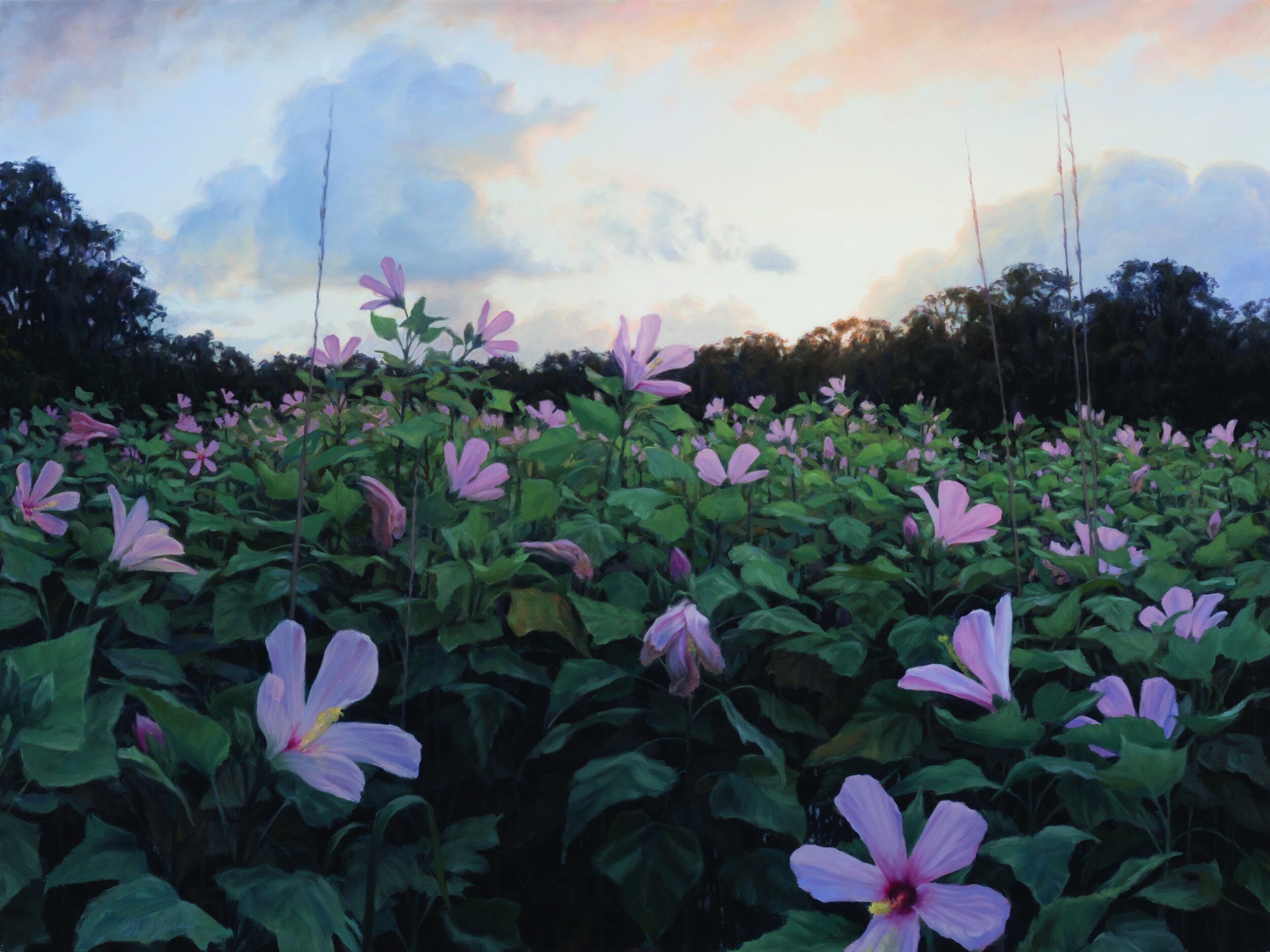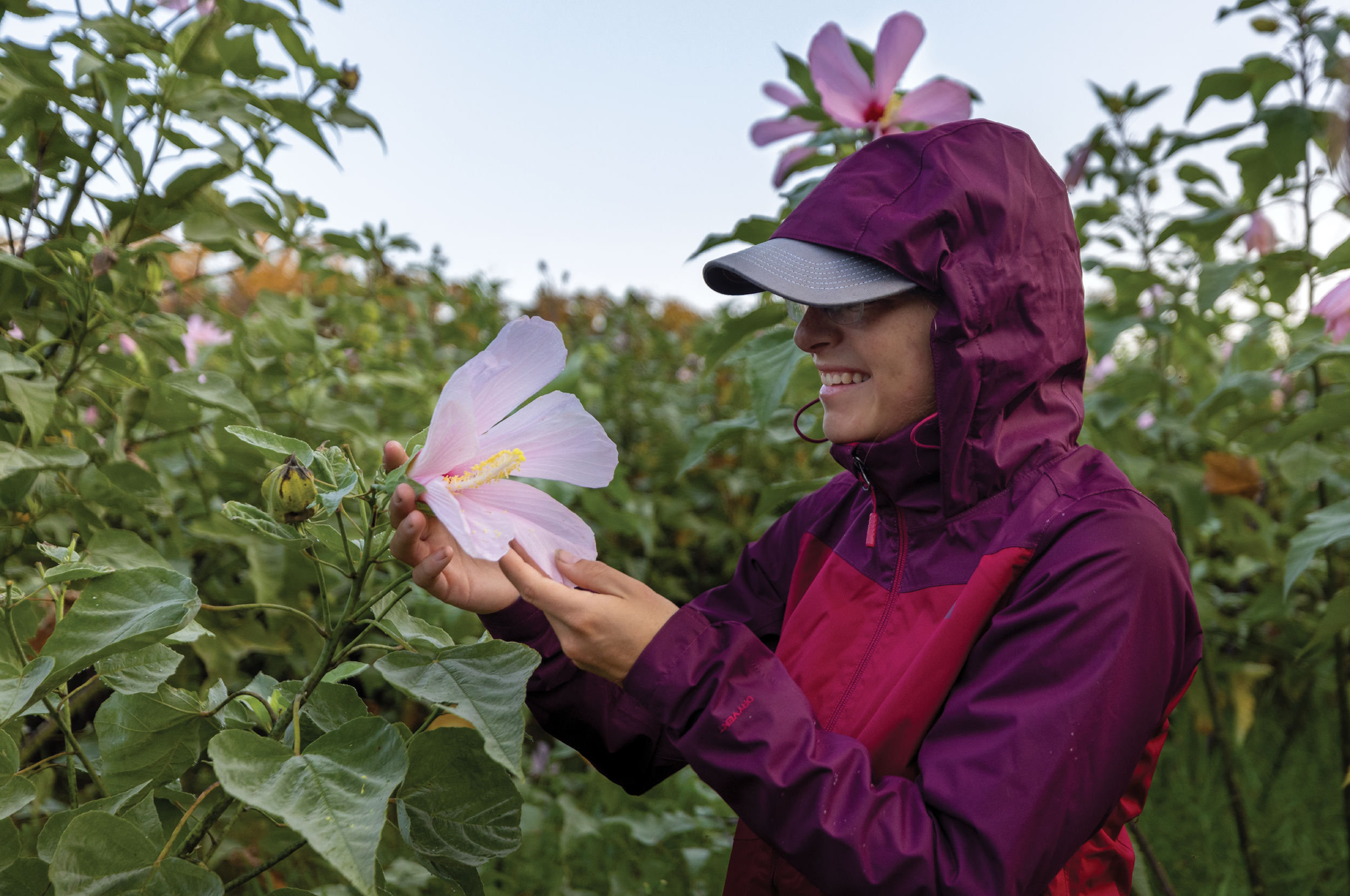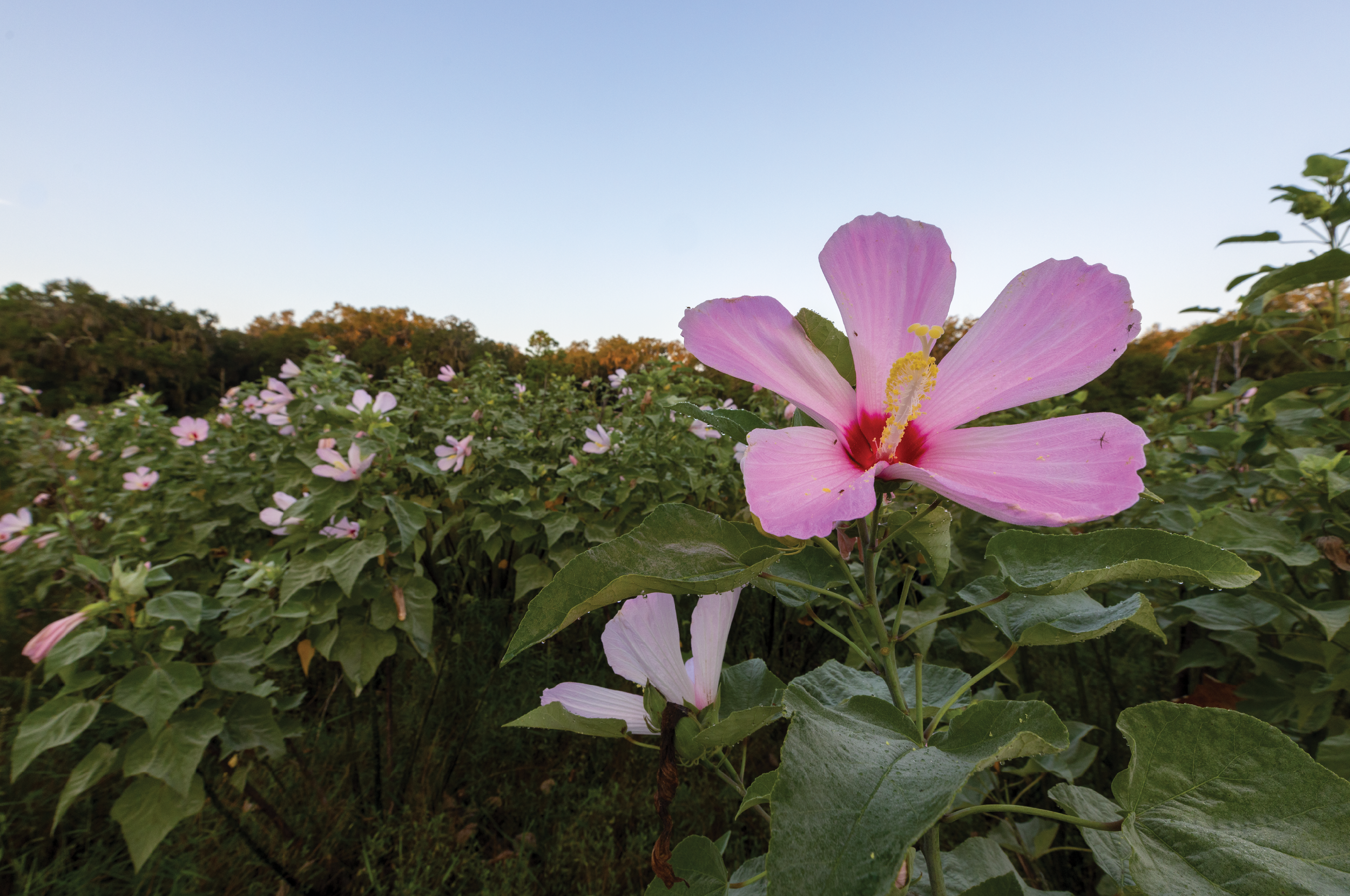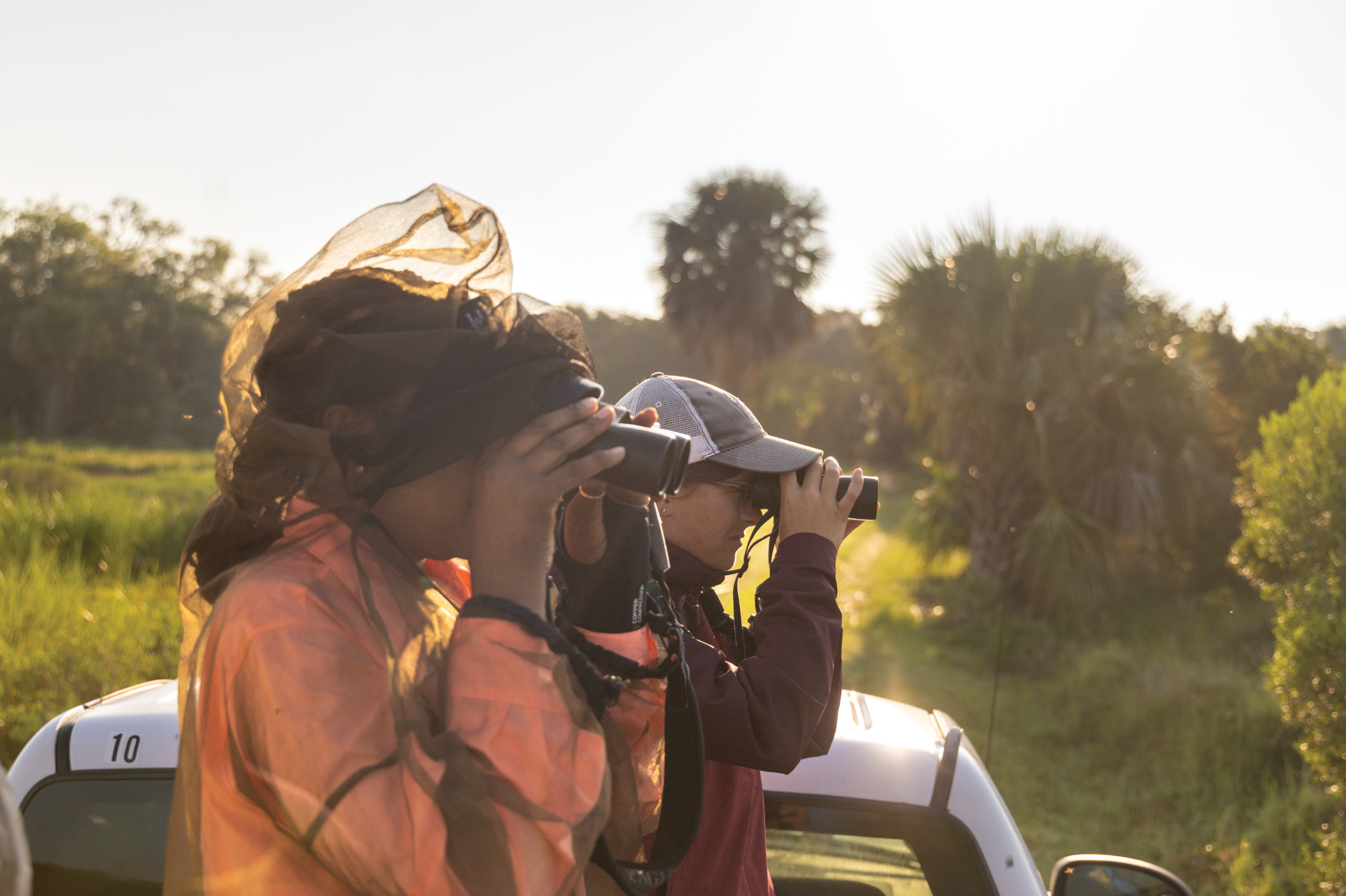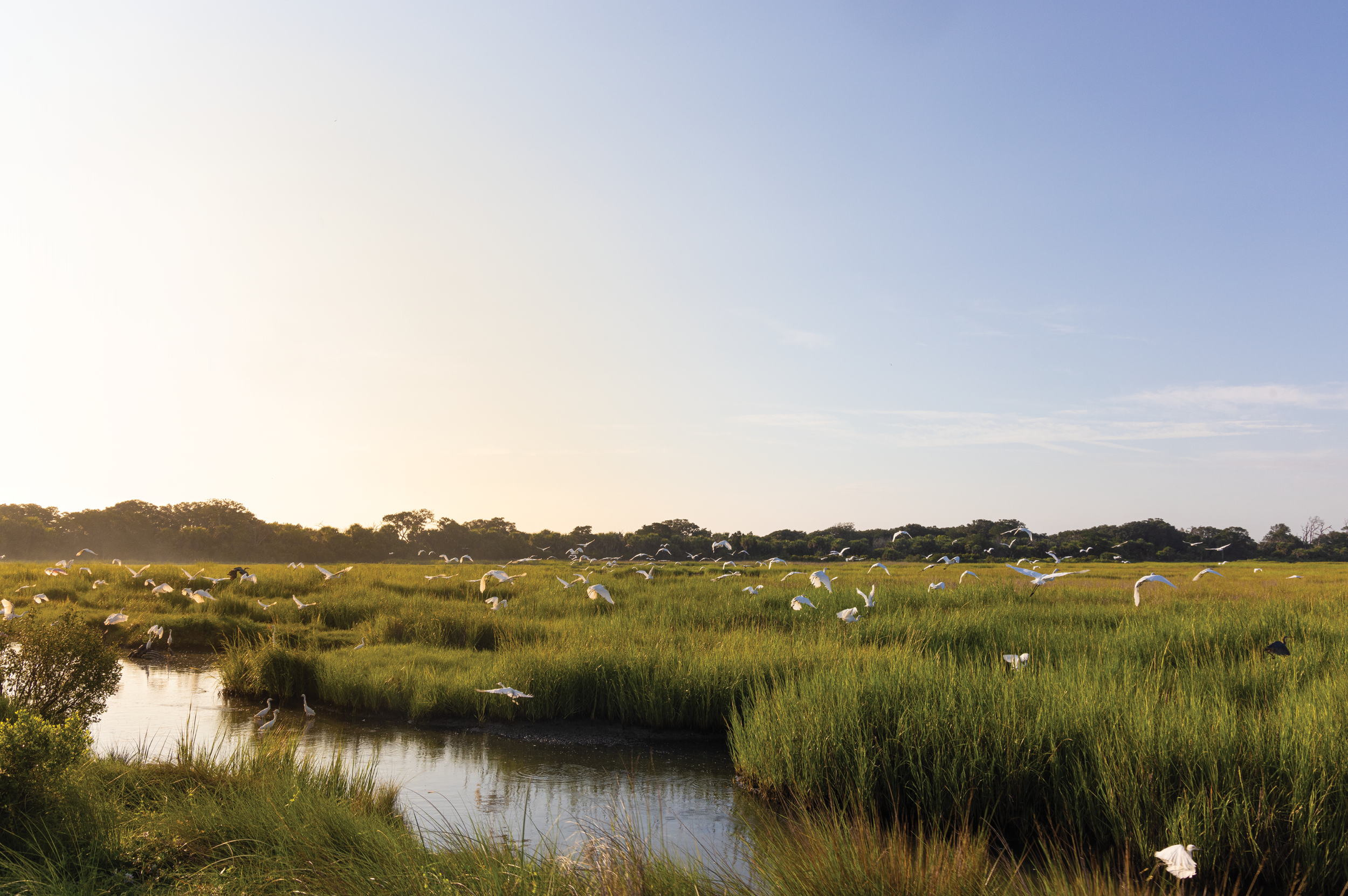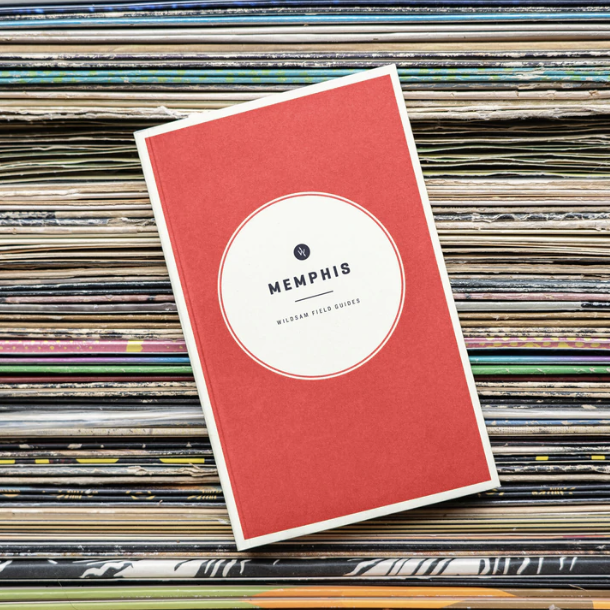The barrier island of Little St. Simons Island in Georgia is one of the few places in the world where you can find Hibiscus grandiflorus — some of the last gigantic prehistoric flowers on the face of the Earth.
Words by Jim Barger Jr.
Paintings by Philip Juras | Photographs by Ben Galland
In the beginning, God created sacred spaces solely for the enjoyment of God alone, places that exceed the boundaries of human imagination and that few people have dared to trespass upon. I have seen such a place — an ever-evolving, self-perpetuating divine artwork of biblical proportions, spontaneously conceived in an instant 4.5 billion years ago and yet simultaneously born anew one hot summer morning. A vast congregation of mint-green stalks towering twice as high as the average human, it’s crowned by an awakening of mammoth pink blossoms that coyly unfurl diaphanous petals to reveal amatory pistils and aroused stamens, stretching proudly to the heavens, raising sacrifices of golden pollen to the rising sun.
As I entered this place, I was reminded of the imperative delivered to Moses on Mount Horeb: “Do not come closer ... for the place where you are standing is holy ground.”
Painting of hibiscus at Flag Pond, Little St. Simons Island, Georgia. (Painting by Philip Juras)
To get there, I began walking after sunrise on a late-July day, wearing high rubber boots and a mosquito net over my head, into the interior of one of Georgia’s 16 barrier islands, inaccessible except by boat, beyond miles of saltmarsh and serpentine tidal waterways, deep into the island’s secluded core. I traversed maritime forest canopied by live oaks dripping with Spanish moss and aged muscadine vines as thick as my wrist. I picked my way through a nearly impenetrable understory of saw palmetto on a 5,000-year-old dune ridge. Startled rattlesnakes and water moccasins disappeared before me into the brush. Alligators thrashed their tails in black water wallows before vanishing beneath the surface of rippling sunlight and shadows.
It’s the very sort of place you might expect to find some of the last gigantic prehistoric flowers on the face of the Earth.
Hibiscus grandiflorus, also known as the large-flowered hibiscus or swamp rose mallow, is a rare, enormous, prehistoric flowering perennial endemic to fresh-water wetlands in the Deep South. It is rarely seen by humans because it grows only in a particularly secluded habitat and its blossoms open only at dawn and dusk, closing against the stifling heat of the summer sun for all but a few hours each day.
A member of the mallow — or Malvaceae — family, the large-flowered hibiscus is a kissing cousin of two of the South’s most iconic plants: cotton and okra. Eurasian and African relatives of the swamp rose mallow were historically used to make sweet confections (think, marshmallows) and invigorating beverages (hibiscus tea). Worldwide, there are more than 4,000 mallows, the largest number of which are of the Hibiscus genus, whose showy flowers have been understood as a euphemism for sexual desire since ancient times — the most notable example being the allusion to a hibiscus flower as the metaphorical “Rose of Sharon” in the ancient erotic love poem Song of Solomon. Today, there are only a handful of places in the world where the largest, most flamboyant species of these wildflowers continues to grow.
In South Carolina, where Hibiscus grandiflorus once flourished, it’s now presumed to be extirpated. According to NatureServe, the organization that catalogs the most authoritative biodiversity data on North American flora and fauna, there is “virtually no likelihood” that the large-flowered hibiscus still exists in South Carolina. Despite “intensive searches of historical sites and other appropriate habitat,” no trace of it has been found there in decades. Across its historic range in Florida, Texas, Louisiana, Mississippi, and Alabama, people gave up looking for the enormous pink blossoms a long time ago. In Georgia, Hibiscus grandiflorus blooms were documented 25-plus years ago near Savannah and Darien, but those sites have been relegated to the annals of natural history. Someone reported seeing swamp rose mallow in a wetland in southwest Georgia sometime over a decade ago, but none have been documented there since.
So if you want to see the miracle of a Hibiscus grandiflorus in the 21st century, there’s only one place left to look: the barrier islands of coastal Georgia. And to fully appreciate these rare giant flowers, you first must understand and appreciate the natural history of the islands themselves.
During the twilight of the 2.5 million-year Pleistocene Epoch, Georgia’s oldest existing barrier islands began to form. It was the end of a period of dramatic global climate change, during which large portions of the Earth’s oceans froze and thawed again and again and again. Dynamic sea level changes tied to the succession of the four Pleistocene ice ages ultimately resulted in what we now call the Silver Bluff — the subtle ridge running north from Cumberland Island at the southern end of the state through the centers of the islands of Jekyll, St. Simons, Sapelo, St. Catherines, Ossabaw, Skidaway, and Wilmington. As the Pleistocene ended and the Holocene Epoch began around 12,000 years ago, our youngest islands started forming east of the Silver Bluff — Little Cumberland, Sea Island, Little St. Simons, Wolf, Blackbeard, Wassaw, Little Tybee, and Tybee — marking the outer edge of Georgia’s current coastline, which continues to change every day in sometimes subtle and sometimes dramatic ways according to the urges of nature and the various impulses of humankind.
The untold story of Hibiscus grandiflorus is really the untold story of the freshwater wetlands of Georgia’s barrier islands. It begins in the interior of Georgia’s coastal plain at the sources of the five major river systems that drain into the Atlantic: the St. Marys, the Satilla, the Altamaha, the Ogeechee, and the Savannah. As these rivers flow out of their watersheds into their respective estuaries, they carry clay sediments that ultimately wash into the barrier islands through tidal creeks. The sediments settle in low areas where they act as a sealant — preventing percolation and trapping rain — creating an oasis of freshwater in a habitat otherwise surrounded by salt.
Looking at a satellite map of Georgia’s coast, I can see immediate evidence of how these freshwater wetlands were made. Their predominantly linear shapes roughly align with the north-to-south near-shore currents that overtake each of the easterly flowing rivers as they intersect the ocean. As these freshwater wetlands emerge behind the primary dunes, they quickly develop into beach meadows, thick with various wildflowers: bunches of aromatic purple-pink-blossomed sweetscent, twining clusters of delicate pink-and-white climbing hempvine, creeping mats of purple-coned, white-petaled frogfruit, and vast sheets of vivid marsh pink, stenciling the wetlands like technicolor stars in an impossibly green reflection of a cartoon sky. Dozens of species of butterflies, moths, and skippers feast on the nectar of these relatively diminutive blossoms.
Hibiscus grandiflorus, or swamp rose mallow, is a rare, enormous, prehistoric flowering perennial that grows in the coastal freshwater wetlands of the Deep South. Its pink blossoms are so big that it’s possible to identify them from 500 feet above the tree canopy.
Each spring and fall, I sit on the beach and watch the mass migration of monarch and fritillary butterflies as they dance across the sky against the pale background of the ocean’s waves. Slowing down long enough to watch this mesmerizing miracle, gazing across the ocean, I’m reminded that somewhere behind me, just beyond the dunes, are blankets of wildflowers in shallow ponds of trapped freshwater where these weary pollinators refuel on their biannual journeys up and down the seaboard.
While many of these near-shore interdunal wetlands have remained for centuries and others continue to be made anew, some wetlands have migrated over long periods of time to eventually become enclosed by maritime forest. And as the flora around these wetlands succeeded from dune grasses to woodlands, the beach meadow wildflowers that once grew within them also succeeded to other freshwater wetland flowering species like cattails, orchids, canna lilies, and wood sage. It is here, in these secret spaces that survive deep within Georgia’s barrier islands, that you might also hope to find the resplendent spectacle of what could be known as the celebrated charismatic megaflora of the Southern coastal wetlands — Hibiscus grandiflorus — except the vast majority of people in the world have never even heard of it.
My friend Scott Coleman would like to change that. If he had his way, Hibiscus grandiflorus would become as familiar as the giant panda, mountain gorilla, and polar bear. While most of us haven’t seen those animals in the wild and never will, we immediately associate them with efforts to conserve the ecosystems where they struggle to survive. Conservationists call such emblematic animals “flagship species.”
A zealous advocate for barrier island wetlands, Scott has dedicated his entire adult life to conservation of the Georgia coast as Ecological Manager for Little St. Simons Island, the 11,000-acre unspoiled wilderness that holds the largest stands of wild swamp rose mallow left in the world.
“One of the things that first struck me about Little St. Simons when I arrived years ago was just how intact the ecosystems are here,” Scott said. “And that includes the freshwater wetlands.”
Except for a small eco-lodge, Little St. Simons is completely undeveloped. The island is protected by a perpetual conservation easement held by The Nature Conservancy donated by the island’s owners, Wendy and Hank Paulson, two steadfast conservation philanthropists who employ Scott and a team of naturalists to implement a long-term ecological management plan and research program on the island.
“As I learned more about the rest of the coast, I’ve especially come to appreciate how intact the freshwater wetlands are here on Little St. Simons ... and the role that they play in the larger ecosystem ... and how threatened all of our barrier island wetlands are by sea-level rise and development,” Scott said.
Like Scott, Christa Frangiamore Hayes is a stalwart coastal conservationist who was once an ecological manager of state-owned Jekyll Island. About 10 years ago, the two of them flew over the entire 100-mile Georgia coastline to locate freshwater wetland stands of Hibiscus grandiflorus (the mere fact that you could hope to locate a particular wildflower species from 500 feet above the tree canopy testifies to the size of these blossoms).
They described seeing large swaths of pink blossoms near Lake Whitney on Cumberland Island as well as on the southern end of Jekyll Island and in the interiors of Sapelo and Ossabaw. Christa, who also spent years observing wildflowers and pollinators on St. Catherines Island, lamented that the meadows of giant swamp rose mallow that once existed there in the interdunal swales are now gone.
She recalled happily observing everything from armies of bees to butterflies to even anoles — the ubiquitous green lizards of the Southern coast — feasting on the nectar and pollen and lounging in the enormous petals of the giant hibiscus. While there may still be some stands of hibiscus in the interior wetlands of St. Catherines, Christa confirmed that salt water intrusion killed the populations that once flourished behind the beach. The large-flowered hibiscus can toleratewindblown salt on its leaves, but it cannot survive for long in standing saltwater, making it particularly vulnerable to sea- level rise and a desperately depleted groundwater system.
Although largely dependent upon rainwater, coastal freshwater wetlands also are fed by groundwater, especially during times of drought. When rainwater becomes insufficient, alligators dig wallows tapping into the groundwater, providing a lifeline for a wide variety of plant and animal species. Sometimes these alligator wallows serve as the sole source of freshwater on barrier islands when the rains refuse to fall. But when the water table drops dramatically, as it has over the years due to overdevelopment, alligators can’t dig deep enough on our barrier islands to access freshwater, and nearly every species of plant and animal in these ecosystems surrounded by salt becomes imperiled when the last of the standing freshwater evaporates.
Little St. Simons naturalist Allie Smith inspects blooming hibiscus flowers.
When I was growing up on St. Simons Island in the 1970s, the water table was so high that fresh water bubbled up naturally onto the beaches from artesian springs. As children, we simply dipped our hands into depressions in the sand and lifted the cool water to our lips. Now those natural springs are gone, and my children fill steel water bottles from the tap. They look at me as if I’m telling a fairy tale when I reminisce about freshwater gurgling up out of the earth.
I shared that anecdote with Christa and Scott, and they both went silent. Scott bit his lip and stared at me. As coastal ecologists, they understand the implication of the story. Christa’s voice cracked as she responded. “All of the barrier islands had artesian springs back then,” she said. “And a lot of people on the coast still had wells in the 1960s, ’70s, and ’80s. But those wells went dry literally overnight, and a lot of the old coastal families didn’t have the money to pay for a deeper well. So, many of them had to just move away. It’s a sad story to me — one that nobody talks about.”
We lost a lot of our history and culture that way on the islands. It just dried up. It was mostly the old Gullah-Geechee families who were forced to flee the islands, families whose proud, resilient ancestors arrived as enslaved people after surviving the horrors of the Middle Passage. Some of the old white families, who also were stewards of the coast for generations, eventually drifted off the islands in much the same way. Beautiful vacation homes, golf courses, and resorts now dominate our coastline, but few people are left with historical ties to the place, who understand how to live in harmony with creation here, and who are connected to one another by communal ties and a generational love for the beauty of the place.
“What has always struck me about the wetlands is their immense beauty,” Scott said. “These wetlands are the flower gardens of the island, and there is value in preserving beautiful places because that is how you get people to care about them, to be drawn to them, and to preserve them.”
The human soul longs for the beauty of the natural world. “Our relationship to Nature is primal,” observed evolutionary biologist E.O. Wilson in probably one of his most underread books, The Creation: An Appeal to Save Life on Earth. “The emotions it evokes arose during the forgotten prehistory of mankind, and hence are deep and shadowed.”
I was reminded of Wilson’s words as Scott described the first time he came over an ancient dune ridge and saw Hibiscus grandiflorus in bloom.“There was this cotton-candy pink as far as I could see, and I was just blown away by the beauty of it. I couldn’t get over it. It haunted me. And then I began taking a few friends, like you, to see it who I knew would also appreciate it.”
Just as Scott encouraged me to write about Hibiscus grandiflorus, he also urged artist Philip Juras to paint it. Philip is perhaps best known for his engaging series of Southern landscapes that depict the natural scenes described by 18th-century botanist William Bartram, who explored the Southern wilderness between 1773 and 1777. Philip visited the scenes from Bartram’s writings and painted more than 60 of them, which were published in the award-winning book The Southern Frontier: Landscapes Inspired by Bartram’s “Travels.” Philip also published a book of paintings of year- round natural scenes on Little St. Simons, including one astonishing painting of a large barrier island wetland in full bloom, with wild Hibiscus grandiflorus towering up to the skyline as far as the eye can see.
“It’s like bamboo in a way,” Philip told me about his experience, as an artist, of engaging with the giant wildflowers.
“When you’re in bamboo, there is really no way to understand what you’re looking at. You have to get outside of it. You leave those maritime live oak woods where you’re being mobbed by mosquitoes, and you get out in the wetland ... and you enter this otherworldly place.”
Flag Pond Hibiscus Study, Little St. Simons Island, Georgia, August 6, 2013, oil on paper, 8 x 10 in. (Painting by Philip Juras)
I asked him how he captured the breadth of the scene, the immensity of it. Having walked among the giant flowers, it’s hard to imagine how a visual artist could overcome the difficulty of re-creating it with the limitations of a two-dimensional canvas.
“While I’m in the environment, I’m hunting for compositions,” he said. “I’m trying to take in the full breadth of this overwhelmingly exotic environment that is like nothing else, and I’m also noticing little vignettes like an anole over here and a really tall stem of last year’s plume grass over there sticking up above everything else and a spider web stringing all the way across to another stem, catching the light.
“From a painter’s perspective, the experience at eye level is what I’m reaching for ... I want the viewer to experience it in the way a viewer really would.” He described moving to the edge of the blooming wetland in order to communicate the grand scale, striving to capture “both the atmosphere of the sky and the telltale edge of live oaks so that you get a sense that you’re surrounded by something else and then a little reflection of water down at the bottom ... to just get the idea that this is a wetland.”
Philip’s painting captures a moment in time as the Earth awakens and the strange wildflowers slowly open their petals before wilting in the stifling midmorning sun. It’s a remarkable celebration of one of the grandest moments in the natural world, but I can’t help but think that it may also be a eulogy for a place soon to be gone.
In February, I walked among dormant stalks of Hibiscus grandiflorus on Little St. Simons, a vast field of silver and gray with shrunken flower heads shivering against the wind, shaking their last seeds onto the damp earth. The brittle carcasses of brooms edge and foxtail and dead wildflowers crunched underfoot. My wife, Burch, and I looked out across the winter expanse trying to remember the scene from August. But with the color gone, it’s hard to believe the towering pink blossoms ever existed at all. Yet there’s an evocation of spirit in a freshwater wetland, even in the dead of winter, a sadness blended with hope that isn’t altogether different from the effusive feeling of standing among the elusive blooms during a summer sunrise. Then, above the gently moaning wind, we heard the improbable sound of laughter.
Our companions, Brandi Griffin and Kate Tweedy, were huddled together, bending over to inspect dried seedpods, marveling at the evidence of biodiversity scattered across the deceptively lackluster winter muck, reading the melancholy landscape like a secret diary. Both Kate and Brandi are trained naturalists and enthusiastic botanists who hold the promise for the next generation of conservationists of our freshwater wetlands.
“I think it’s easy to fall in love with a coastal wetland when the giant flowers are blooming,” Kate said. But she recognizes that the dormancy of winter also holds its own sort of magic and that there is also joy to be found among the more accessible, smaller wetlands scattered among the sprawl of human habitats.
“I’ve seen a variety of different coastal wetlands — and not just in these amazing wilderness areas. I’ve also seen them on more developed islands in the Carolinas and Georgia. Each has something different to offer. I’ve seen plants blooming in the fall and migratory butterflies in the tens and even hundreds in these little biodiversity pockets in more urban and suburban areas. They’re all worth observing and preserving.”
Paula Garrett (front) and Allie Smith view flying birds on Little St. Simons.
Like Kate, Brandi is captivated by wetlands. Born and raised at the edge of Georgia’s Okefenokee Swamp — the largest freshwater wetland in North America — her family has farmed south Georgia for generations. “I grew up in wetlands,” she said. “Some of the first plant communities I remember were giant pitcher plant bogs and other rare carnivorous plants like the tiny white-petaled bladderwort and all kinds of good stuff like that.” As a child, Brandi tended the family garden with her grandmother, absorbing a homegrown wisdom that eventually merged with the scientific knowledge she acquired through field study in graduate school and as a naturalist on Little St. Simons.
“It’s all interconnected,” Brandi said. “The way the barrier island freshwater wetlands formed through accumulated sediment in basins between dune ridges is exactly the same way the Okefenokee formed. Trail Ridge, that borders one side of the swamp, is believed to have been an offshore barrier island itself once upon a time.” She paused, smiled, and with a look of infinite resignation added, “That, as you know, is what they want to mine.”
In 2020, the Army Corps of Engineers inexplicably issued new guidance, gutting protections for the Okefenokee under the Clean Water Act. For nearly half a century, the Okefenokee has been globally recognized as a wetland of international importance. But now a fight for its survival is underway as Twin Pines Minerals LLC hopes to generate profits for its investors by mining the rich titanium mineral sands underneath Trail Ridge, the vital barrier that holds water in the swamp.
Clouds passed across the blue winter sky as Brandi gazed out over the expanse of dormant Hibiscus grandiflorus in Willow Pond on Little St. Simons, and it became evident that she was thinking of home. “You know,” she said, “in a weird way, with this barrier island freshwater wetland we are watching right here, right now, we may very well be witnessing a potential new Okefenokee forming in real time.”
What a staggering observation. Amid the seemingly unavoidable pessimism that hangs over the conservation struggle, it is somehow both unnerving and oddly comforting to take the God’s-eye view every once in a while, or as Socrates exhorted, to ponder the earth and the actions of humanity with “magnificence and the contemplation of all time and being.”
“Oh, look!” said Kate, squatting down in the mud. “It’s the first green bud of hibiscus sprouting from last year’s stalks!” And sure enough, emerging from the mire was a cluster of gently unfurling little leaves that over the next six months would morph into just one among thousands of towering Hibiscus grandiflorus stems crowned by lusty prehistoric pink blossoms, besieged by millions of hungry hummingbirds, butterflies, skippers, moths, beetles, spiders, bats, lizards, and bees. And somewhere hidden in the moss of a wind-warped live oak at the edge of the maritime forest, I thought I heard a yellow-throated warbler singing from an unseen perch. The earliest of migrants, the diminutive songbird is always the first to arrive on Georgia’s coast, and its clear, lonesome trill is understood by those of us who know and take the time to listen as the first foreshadowing of spring.
Jim Barger Jr. and his wife, Burch, are natives of St. Simons Island, Georgia, where they live with their two sons. As a family, the Bargers are heavily involved in coastal conservation, environmental stewardship, and equity initiatives in their community. Jim regularly writes about these issues and is currently completing a forthcoming book for The University of South Carolina Press concerning coastal Georgia’s reckoning with the murder of Ahmaud Arbery in light of the region’s tortured history of racial injustice.
Philip Juras is an artist living in Athens, Georgia, whose paintings express his desire to both explore and understand the patterns of the natural world. His recent projects include Georgia’s barrier islands, fire-adapted landscapes of the Southeast, tallgrass prairie restoration in Illinois, and the páramo and cloud forests of the Colombian Andes. Philip has had solo exhibits at the Chicago Botanic Garden in Illinois; the Telfair, Morris, and Marietta-Cobb museums in Georgia; and the Biblioteca Virgilio Barco in Bogotá, Colombia. He has published three books in conjunction with his exhibits, one of which won a Georgia Writer of the Year award.
Ben Galland is a native of St. Simons Island, Georgia. He co-founded h2o creative group, a Brunswick, Georgia, marketing agency, where he is the principal photographer. Photography and the outdoors are his passions, and when not shooting commercially, he can be found in the woods or on the river with a camera.



